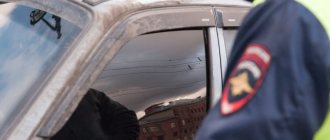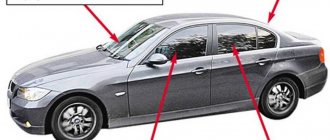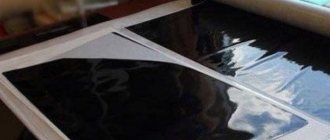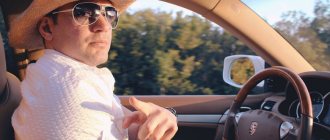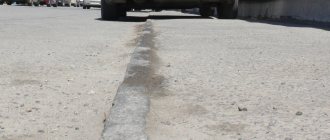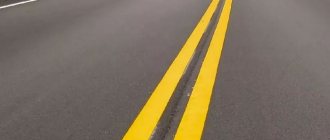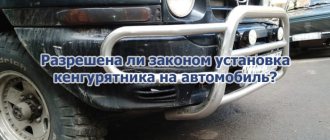Table of contents
- Regulations
- What is prohibited
- Where can you be checked?
- How is the check carried out?
- Code of Administrative Offenses - articles and fines
- Is it possible to challenge a fine?
- Useful tips
- conclusions
If you tint your car incorrectly, you risk getting a fine. Therefore, it is important to understand what the correct tint should be, what is prohibited, and what punishment may follow. In this article, we will try to cover all these questions in as much detail as possible.
Regulations
Before you figure out what the fine for tinting front windows is in 2021, it’s worth understanding what the penalties are based on. There are only three documents regulating the light transmission of car windows.
- GOST 33997-2016. This document regulates the main points for admitting vehicles to operation. It is this document that the SDA is based on, that is, all technical characteristics mentioned in the “rules” must be checked against this GOST.
- Technical Regulations of the Customs Union “On the safety of wheeled vehicles”. This is an expanded document that is valid not only in Russia. Among other things, there are also instructions on what tinting is allowed and other important nuances.
- Order of the Ministry of Internal Affairs No. 664. Announced in December 2021, it describes the capabilities of traffic police officers to check the tinting of car windows.
- Code of Administrative Offenses of the Russian Federation Article 12.5 clause 3.1. The amount of fines and other sanctions related to the degree of tinting of the car is indicated here.
- GOST 27902-88. Regulates the rules for measuring the transparency of automobile glass. We’ll tell you later how it’s used and how it can help a car enthusiast. Now it is enough to understand that this document is valid and can influence the preparation of the protocol.
Based on all the documents described, the inspector will issue you a fine or release you.
Tinting in Russia and abroad
The “tinting boom” in Russia happened in the mid-90s, when car owners had tint films at their disposal. Since most cars in Russia at that time were domestically produced, everyone wanted to make their car stand out and do styling that was unusual for those times—tinted windows. And, since there were no restrictions on tinting, many “connoisseurs of beauty” tinted their cars tightly, including even windshields.
While one can still argue about the beauty of such tinting, there can be no two opinions regarding the level of safety, which decreases along with visibility. Tinted windows, which allow almost no light to pass through, increase the likelihood of accidents several times.
Today it is possible to make “deaf” tinting, but now there are state requirements for the light transmittance of automobile windows, which are recommended to be adhered to. So, for the windshield the light transmittance rate is at least 75%, and for the side windows - at least 70%. In addition, ideas about beauty have changed a little, and most modern drivers no longer consider completely black car windows to be a stylish design element.
In almost all other countries, the requirements for tinted windows are exactly the same as in Russia. True, in some states there are complete or partial bans on tinting. For example, in Tajikistan, only top officials of the state are allowed to tint a car, and in France and Holland, only the rear side windows and rear windshield are allowed to tint.
What is prohibited
To understand which tint cannot be used, you should refer to GOST 33997-2016 and the technical regulations of the Customs Union (CU). It is these documents that regulate transparency tolerances.
The first thing to note is that windshield tinting is now allowed up to 70% light transmission. The previous edition of GOST stated that only 75% or higher is possible. Now GOST has been brought into compliance with the technical regulations of the Customs Union, where this has been allowed since 2011.
However, the rest of the glass on the car is not regulated. It turns out that the front and rear side windows can be tinted even tightly. Although there are some exceptions. If you do not have side mirrors, you may be fined for completely tinting the rear window; this hemisphere must in this case have at least 70% transparency.
There are restrictions on the use of some types of tint. Let's figure out which tint film on a car is a violation.
- Mirror film. Such tinting not only darkens the interior, but also reflects light rays. This may cause blinding to other road users. To avoid emergency situations, the regulations included a complete ban on such tinting. Typically this type is a metallized film coated with aluminum.
- Color film. We are talking about green and blue tints. They are characterized by distorted color rendering, which reduces the driver's visibility. This is especially noticeable at night. Accordingly, such films were considered unsafe.
- Chameleon. Refers to color films, characterized by the ability to change color depending on the angle at which light rays fall. In many respects it is similar to mirror tinting. It is prohibited due to the risk of blinding drivers, and studies also show that such a film impairs the degree of visibility from the driver's seat.
GOST and technical regulations also indicate how glass should transmit light, what color rendering it should have and other parameters. But, as part of the consideration of tinting standards, this data need not be studied.
Car tinting: yes or no?
Although, of course, there are no comrades in taste and color - someone likes to expose themselves to review, being in the leather interior of an expensive car and looking at other road users from the height of the clearance of their jeep, material well-being and good taste.
Well, this article is not for them. And not for those who want to save a few pennies and for this reason do not darken the windows of the entire car.
So, tinting. Let's look at the pros and cons. Of the unconditional and objective advantages
the following can be distinguished:
Cars with tinting are much less likely to become victims of auto scams. Don't believe me? Talk to the traffic police. Owners of tinted cars are significantly (!) less likely to become victims of so-called purse snatchers. In parking lots, personal belongings left by the driver or passengers are very rarely stolen from tinted cars. Owners (and this is especially true for female drivers) are also significantly less likely to become victims of robbery with the aim of taking possession of a car. This applies, first of all, of course, to expensive and high-status cars. The interior of a tinted car does not fade and remains “new” longer. A tinted car has better interior insulation. That is, it has significantly less heat/cold loss through glass. This means that in the summer, for example, your car’s air conditioner will not work at its maximum, but in a gentle mode. This results in fuel savings and increased service life. When broken, tinted glass does not shower the driver and passengers with fragments that remain hanging on the film.
From the subjective advantages, we can say that being “not in an aquarium” is at least more comfortable.
Now about the cons. Do you know them? But I don’t, you can share.
It is worth special mentioning the myths
.
Myth 1
: Visibility from a tinted car is much worse. This is not true, except in those cases when someone, due to innate idiocy, rolls up all the car windows in a “circular” film with 100 percent or close to light absorption.
Myth 2
: The accident rate of tinted cars is higher. Everything is true exactly the opposite - below. I’ll tell you why another time, because this would take the length of a separate article.
Myth 3
: Tinted cars are stopped more often by traffic police officers. It's not the same here either. More often they stop only during special operations. The rest of the time, less often (true for a large metropolis) or exactly the same (true for driving on a highway).
Now - how to tint
. You can tint the rear window and the side passenger windows of the rear row with a completely opaque film, cover it with plywood and cover it with newspapers - this is possible. If only the mirrors were in place, and you, as a driver, knew how to use them. In fact, the windshield cannot be tinted, with the exception of a strip up to 14 cm wide at the top of it.
The light transmittance of the windshield, by law, must be at least 75%, which does not allow the application of any film or spraying, since glass itself, without coating, does not allow one hundred percent of the light to pass through.
The side windows, driver's and passenger's, must let in 70% of the light, so there's not much to see here either.
But don't forget about deflectors! This is an aerodynamic thing that is glued to the top of the doors and prevents the wind from blowing into the interior of the car when it drives with the windows slightly open. They are often made translucent from a dark, smoky plastic. With the successful selection of this simple device, its width and reach, it can also be used to perform an unusual function, namely, reducing the “transparency” of the car. And what is important is that the use of deflectors is not stipulated by law.
In practice, you can get an almost opaque car interior without breaking the letter of the law - by purchasing a car with a black or dark gray interior; dimming of the rear window and side rear passenger rows, as they say, “to zero”; applying a fourteen-centimeter dark stripe to the windshield; tinting the side windows by 30% and selecting wide deflectors.
Your car will no longer be an aquarium according to the law.
Tags: creative thought, windows, tuning, cars, design, glass
Where can you be checked?
A common mistake is the belief that the inspector cannot check the tint on a car outside a stationary traffic police station. As a result, drivers relax and get fined.
Previously, such a norm actually existed, but Order of the Ministry of Internal Affairs No. 664 amended the usual course of things. Now traffic police officers have the right to check tinting in any place that is not prohibited by internal orders. That is, restrictions are imposed only by the head of the territorial traffic police unit. In practice, it turns out that there are no prohibitions, and the check can be carried out in any convenient place.
Also, Order of the Ministry of Internal Affairs No. 664 regulates the inspection process and the documents that the inspector must show. He must have all the documentation for the taumeter. At the driver’s request, he must also provide documents certifying his admission to such measurements.
Important!
Of course, you can ask for permission, but this is a useless shaking of air. Now all inspectors undergo such training before entering service. Therefore, if in front of you is a traffic police officer, he has permission.
If we are talking about a visual determination, for example, with a fine for mirror tinting. Here the inspector is obliged to record the violation in the photo.
The order regulates the possibility of attracting witnesses. By default, the measurement is carried out without the participation of other people. But the driver can ask to invite witnesses; these can be any random people. The Order does not clearly indicate who can be a witness; usually these are random drivers stopped by an inspector.
How is the check carried out?
It is important to ensure that the test is carried out correctly. The inspector may cheat, and you will then have to prove your case in court. First of all, you need to check the validity of the taumeter certificate. The following devices are most often used.
- Blik-N.
- Tonic.
- Light.
All of them are quite reliable, work without failures, so they are actively used by the traffic police.
Pay attention to the presence of a seal. The device must be sealed. If there are no seals or holographic inspection marks, such a taumeter cannot be used. Of course, maybe the seal was broken by accident, but it’s not worth the risk.
Important!
If the inspector still insists on measuring with a device that does not meet the standards, be sure to indicate this in the protocol. By law you will be found innocent.
Measurements should be taken in three places. This will avoid accidents. For example, an inspector may notice a slight contamination, measure the light transmission in that particular place, and write a report.
If you notice that the measurement was taken in only one place, indicate this point. The protocol must indicate the data of three measurements.
Pay attention to the action of the checking employee. Sometimes they cheat by placing another piece of film under the measuring heads. In this case, it turns out that the glass does not meet the standards. You may not even notice such a trick, so if you doubt the reliability of the measurements, we recommend asking to check the car in the presence of witnesses. This usually cools down unscrupulous police officers considerably.
Checking light transmittance is only possible on the windshield. Only here the level of light transmittance is regulated. When trying to take measurements on other glasses, it is worth pointing out the illegality of this action.
The exception is if you don't have side mirrors. If at least one mirror is missing, the inspector can check the degree of darkness and the rear window. In this case, it should transmit 70% of the light, since it is equal to the frontal one. Therefore, if for some reason you do not have mirrors, and the rear hemisphere is tightly tinted, most likely a fine will be issued.
Important!
The dark time of day and the presence of precipitation are not barriers to measurements. According to the requirements of regulatory documents, measurements can be taken at any time of the day, regardless of precipitation.
Cons of car tinting
The main disadvantage is reduced visibility at night and in bad weather conditions. However, this disadvantage can be eliminated by installing electronic tinting with a light transmission adjustment function. Unfortunately, this option is very expensive.
When the rear window is darkened, visibility through the mirror is significantly reduced. Therefore, reversing will be problematic. The main problem is increased attention from traffic police officers. Statistically, tinted cars are stopped many times more often.
To tint a car or not is a purely personal decision of each car owner. The main thing to remember is that in pursuit of comfort you should not neglect safety.
Is it possible to challenge a fine?
If you have been issued a protocol, do not worry too much; in many cases it can be appealed. There are plenty of reasons for this. Below we will look at working methods for canceling fines for tinting.
Important!
There is no need to argue with the inspector, proving that you are right. He does his job to the best of his ability. And if you start pointing out to him that he is wrong, the employee may well do everything right, and you will not be able to get away from the protocol.
Accordingly, you need to carefully monitor the actions of the police officer, and then, based on his mistakes, go to court.
The most common situation is a violation of the measurement technique. The fact is that the inspector always focuses on the operating instructions for the taumeter. Most devices can be operated at temperatures from –40°C to +40°C. Well, or with minor deviations, for example, “Tonic” can be used at temperatures starting from –30°C. This is the data that traffic police officers rely on.
But, in GOST 27902-88 there are clear instructions regarding the conditions under which measurements should be carried out. These are the conditions that must be met.
- Air temperature 20°C, deviation up or down by 5°C is allowed.
- Atmospheric pressure should be between 86–106 kPa.
- Relative humidity 60%. A deviation of 20% in any direction is possible.
In practice, it is difficult to encounter atmospheric pressure less than 86 kPa, unless you are high in the mountains. Yes, and with a humidity of 40% it will be problematic. But we can encounter temperatures less than +15° and more than +25°.
Here you need to ensure that the inspector enters all the data into the protocol, including temperature readings. If the indicator is not within the acceptable range, you can go to court to cancel the protocol.
Important!
You have 10 days to protest. During this time, you must have time to go to court to cancel the protocol. It is possible to extend the deadlines, but you need a good reason, for example, sick leave or a certificate from work, that you could not apply within the permitted time frame.
When going to court, we refer to GOST 27902-88 and indicate the complete non-compliance of the inspection conditions with the recommendations from this document. In most cases, the court considers GOST a more significant document than the instructions for the device, and cancels the fine without any problems.
Example.
The driver was stopped in winter; the temperature outside was -18°C. The inspector measured the tinting of the front window, found that it did not meet the standards, and then issued a report.
The driver went to court and won. The judge considered that measuring transparency at such a low temperature was a gross violation of the rules for studying the transparency of automobile glass.
There is another way to cancel the fine. But it doesn't always work. This is an incorrect protocol. If the inspector does not enter data into the document, for example, does not indicate the temperature, enters only one measurement result, or makes other errors. This may also be grounds for going to court.
But there are nuances here. The court may request a weather report for a specific day, and if the temperature conditions coincide, the fine will not be canceled.
Examples.
The traffic police officer did not indicate the temperature in the protocol. The car owner went to court, believing that he was being fined unreasonably. The judge, having asked for a weather report, found that the temperature that day was +21°C, which falls within the recommended norms. The protocol remained in force.
In another case, the driver agreed. The protocol was canceled due to non-compliance with the rules for processing documents.
New law for tinting from January 1, 2021
There is a main rule regarding tinting. It says that darkening the windows should not prevent the driver from fully monitoring the road situation, even in the dark. There is tinting of windshields, side and rear windows. For them, the light transmission threshold is different.
As for the new law, this can be called loud words. There are only a few adjustments to this law. Naturally, they will not be in favor of drivers. The main change is an increase in fines for driving with glass whose light transmittance is less than the established standards. Moreover, these norms remain the same.
Important changes
If the tinting does not meet the standards, traffic police officers do not have the right to remove license plates.
But any employee is allowed to test the ability to transmit light on site. Although this is allowed to be done only if certain rules are followed, and with the help of a special device. Now a fine is not the only punishment. Thus, a traffic police officer may require the removal of a film whose darkness exceeds the permissible standards. The driver can remove it directly at the post where he received the reprimand, or at home. As a rule, ten days are given for this. As for the size of the fine, it is 500 rubles for the first warning. However, changes have been made to the law that are subject to review. So, the authorities are going to increase the first fine three times. Thus, it will be 1500 rubles. With subsequent comments, the amount of punishment may increase to 5,000 rubles. However, this project is only under consideration and does not have an exact decision as of January 2021.
( Video : “Will the fine for tinting be canceled in 2021? Should I remove the tinting on the spot? Traffic police tricks.”)
Useful tips
When meeting with an inspector, you need to understand what he has the right to. We have already mentioned that the protocol should include three measurement results. There is a nuance here. All devices are able to save the last 3 measurements, here some inspectors are cunning, creating a situation where the driver receives a protocol.
They simply don't reset the previous "client's" data. As a result, the next car also turns out to be tinted illegally. And try to prove the opposite.
To avoid this problem, make sure that the inspector resets the data before taking measurements. This ensures that the check is performed correctly.
In winter, the receiving and emitting heads may become sweaty when moved from a warm place outside. Inspectors know this and take advantage of this feature. When checking, the indicator changes slightly, by about 5–10%, but this is quite enough. If your glass transmits 71%, you risk getting a fine.
According to the instructions, the inspector must leave the device in the cold for at least 10 minutes, and then also check for fogging. Make sure this has been done.
conclusions
Getting a fine for improper tinting is quite easy. After all, this violation is clearly visible on the road. In practice, you will be fined 500 rubles; no other sanctions are provided. Sending a car to an impound lot is prohibited.
In some cases, it is possible to challenge the protocol. Here you just need to carefully study the legislation and decide whether you can take advantage of these opportunities. Due to a number of technical nuances, measurements of light transmittance on the road often occur with violations.
